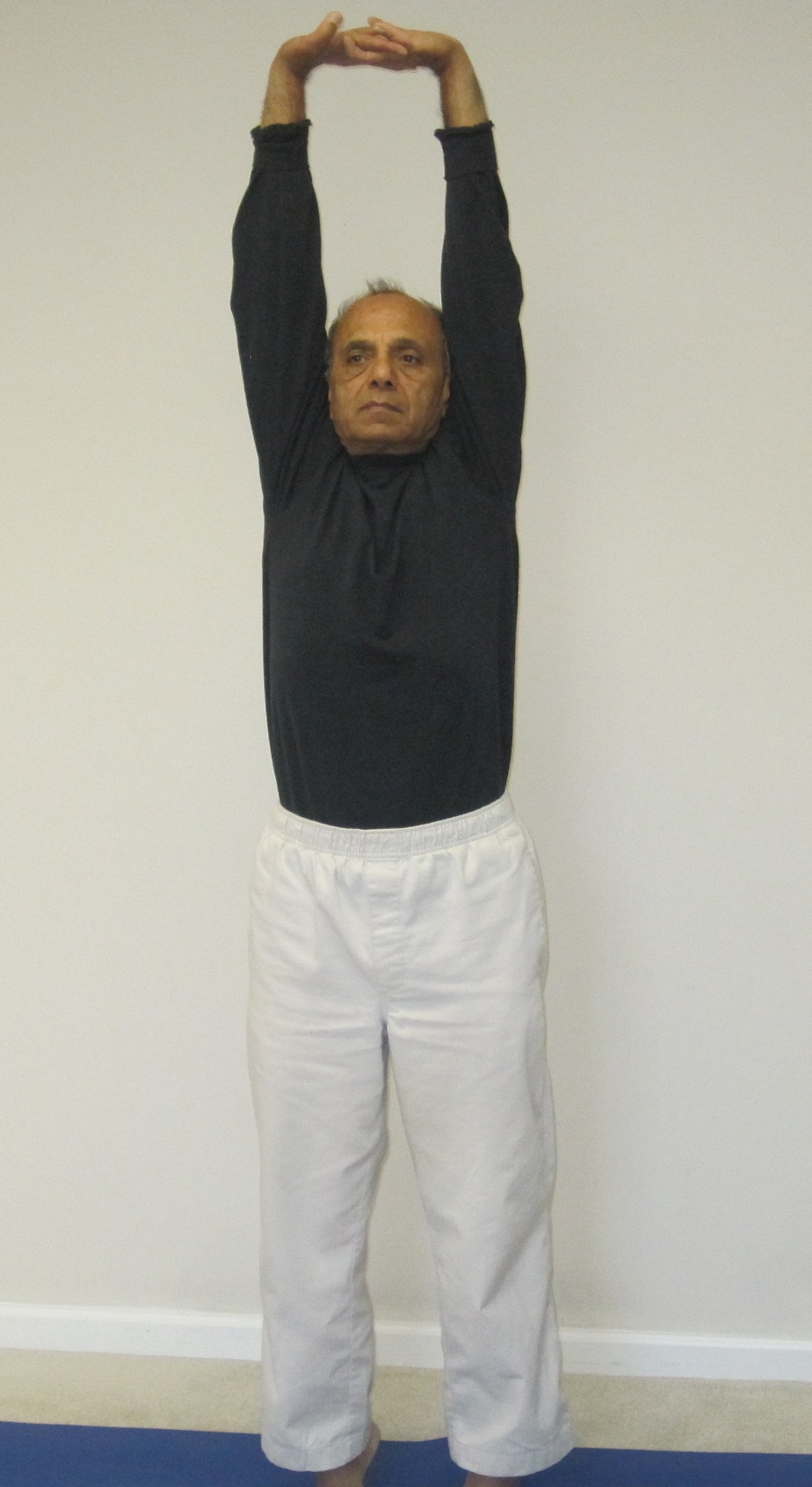Today I am going to talk about a standing stretch, Tadasana (ताडासन), which is a simple pose to practice and yet provides several excellent benefits. The word Tadasana is usually translated either as the Mountain Pose or the Palm Tree pose.
This is an excellent asana for the health of the spine. Because of gravity, all the weight-bearing joints, especially the inter-vertebral joints, get compressed. Over time this constant compression tends to weaken the joints and makes them stiff. Tadasana helps stretch and lengthen these compressed joints and keeps them flexible and healthy. Natural fluids in the body – blood, lubricants and nutrients flow more easily into these joints.
This pose can be practiced as a stand-alone pose or as a counter stretch after the practice of Shirshasana (Head Stand) or Sarvangasana (Shoulder Stand).
Step-by-step
- Stand erect on your mat with the feet about 8-10 inches apart. Keep your eyes open throughout the practice. Constantly gazing at a spot that is not moving, in front on the wall or on the floor, can help maintain good balance during the pose.
- Interlock the fingers of both hands and place the palms on your head. While inhaling, begin to turn the palms upwards and start raising the hands up, stretching the elbows straight. As you stretch the arms up, simultaneously begin to raise the heels up as well.
- Try to breathe slow, deep Ujjayi breaths and synchronize the movement of the arms and the heels with the breathing.
- Now try to stretch your whole body upwards as far as possible. At this point you are on your tiptoes trying to stretch up as high as you can.
- In the early stages of your practice, you may find it hard to maintain balance, but with practice it becomes easier.
- Remain in the final position for two to three breaths.
- While exhaling, slowly begin to lower the arms and the heels together, turning the palms downwards, until the hands are back on your head and the heels are on the floor. Again, keep the movement of the arms and the heels synchronized with the breath.
- Relax for a couple of breaths.
- Repeat the above sequence 3 more times.
Variation 1 – Tiryaka Tadasana
This pose is sometimes referred to as the "wind blown palm tree pose"
Step-by-step
- Carry out steps 1-4 as described for Tadasana. At this point your whole body is stretched upwards.
- Now, with the next exhalation, begin to bend the body to your right, keeping the upper arms glued to the ears, the arms stretched straight and the heels still lifted up.
- Go as far as you can and maintain the final position for 2-3 breaths.
- With the next inhalation, begin to slowly come back up to a full vertical position.
- Once again stretch the body upwards. With the next exhalation, repeat the bend on your left side, staying in the final position for 2-3 breaths.
- With the next inhalation, slowly come back up to the vertical position. In this position, try to give yourself one final upward stretch and then slowly release the hands and the heels down.
- If it becomes too challenging to continue after bending on one side, optionally you can come down as given in step 7 of Tadasana. After resting for a couple of breaths, repeat the above steps to bend the body to the left and back.
- Rest for a couple of breaths and repeat the full cycle 3 more times.
- If keeping the heels raised throughout the pose becomes too challenging, feel free to practice the pose with the feet flat on the floor.
Variation 2 – Supta Tadasana
This is the reclining variation of Tadasana. Here we do the same stretch as Tadasana while lying supine, flat on the back. This pose is often done right at the end of Yoga Nidra (Shavasana) to wake and stretch the body after a long relaxation session.
Benefits
- Stretches, lubricates and revitalizes the inter-vertebral muscles and joints as well as the discs in the spine. This is helpful for people with arthritis and any spinal problems.
- Relieves any pain in the back, neck and shoulders.
- Eliminates stagnation and fatigue caused by lack of movement.
- It is a useful pose for athletes and sports people as it makes the muscles more supple and flexible.
- The effort to maintain balance while in the final pose helps develop better balance both at the physical and mental levels.
- Upward stretch of the abdominal muscles helps improve digestion and eliminates gas from the system.
- Slow and deep breathing during the pose helps increase the lung capacity. We are also bringing in more oxygen into the system, thus energizing every cell of the body.
- The deep upward stretch helps improve circulation in the body and improves the health of the heart.
Contraindications and precautions
This is a simple stretch; so allow the innate intelligence of the body to guide you in and out of the pose. If at any time, your arms, shoulders or the neck muscles feel any discomfort you should come out of the pose. As always, we never try to push through pain in any of the yoga poses.


[…] which clog the mind. An analogous experience in the physical body can be felt when one does the Taadasana as explained by Subhash in his Newsletter a week or two […]